Coronavirus Today: The angst behind those Happy Masks
Good evening. I’m Karen Kaplan, and it’s Friday, Sept. 3. Here’s the latest on what’s happening with the coronavirus in California and beyond.
As we head into Labor Day weekend, we bring you the tale of two tireless entrepreneurs with a bona fide pandemic hit on their hands.
But since the coronavirus has a way of flipping everything on its head, theirs isn’t entirely a success story.
The pair in question are Melinda Hwang and Ed Fu, the West L.A. couple behind Happy Masks. Their $24 face coverings are all the rage, especially among parents whose kids are old enough to be going back to school but are too young to get vaccinated. Indeed, masks sized for children account for about 80% of the company’s runaway sales.
Hwang is a graduate of MIT’s Sloan School of Management and the former marketing director of Capital Group, an investment management firm. Fu has a degree from Harvard Business School and served as chief marketing officer of ZipRecruiter, a hiring website. Despite their credentials, they didn’t set out to create a mask business.
The masks were developed in Taiwan by a scientist who collaborated with Hwang’s father on a new type of filter for wastewater treatment. The 2003 SARS outbreak prompted the scientist to adapt the filter for use in masks, and when COVID-19 burst onto the scene in 2020, he shared some with friends and family.
Hwang, Fu and their three young children wore the masks around their neighborhood. Wearers find that the masks, with a design reminiscent of a parrot’s beak, make it easier to speak and breathe without fogging up one’s glasses. Sewn inside is a nano-fiber membrane filter capable of blocking particles as small as 3 micrometers. (A micrometer is 10,000 times smaller than a centimeter.)
For the record:
1:02 a.m. Sept. 4, 2021An earlier version of this newsletter said a micrometer was only 100 times smaller than a centimeter.
The masks attracted attention, and soon Hwang was asking her parents if she could get extras for friends, neighbors and other acquaintances. As requests poured in, she realized she had the makings of a business.
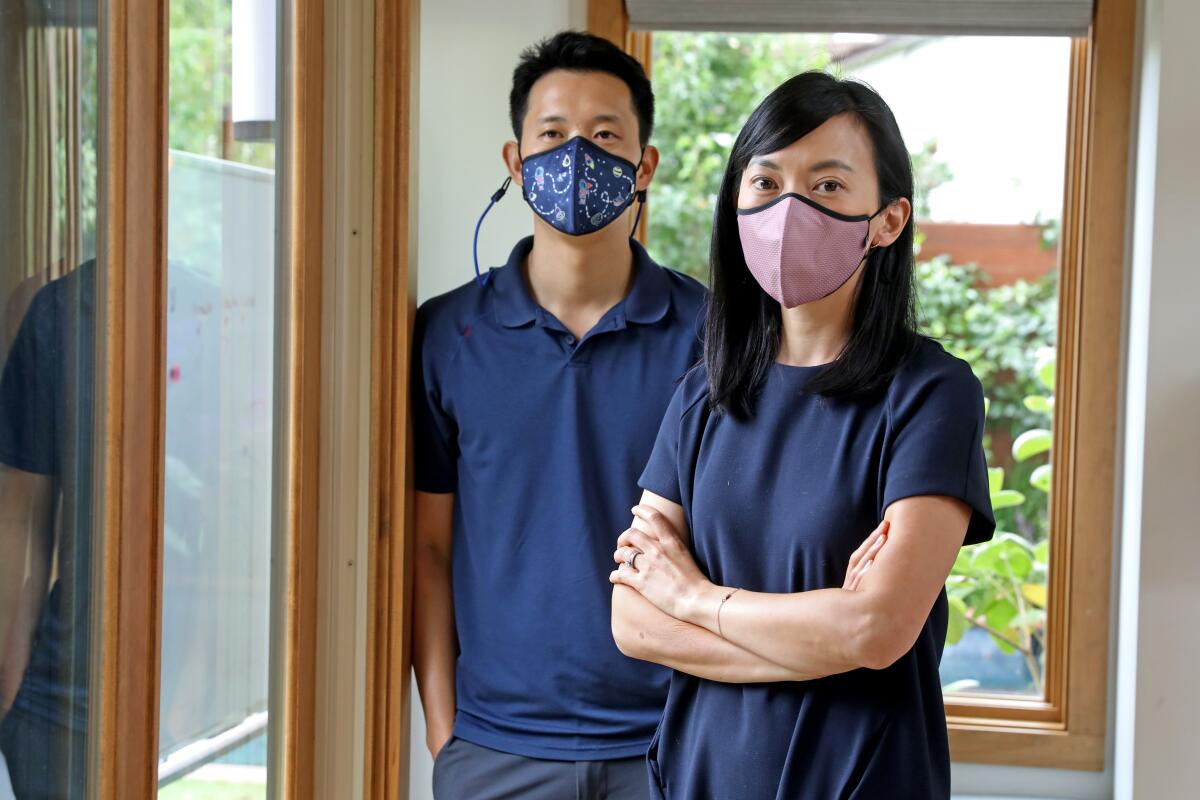
The masks were in demand from the start. Hwang’s first callout to parents in a Facebook group for one of her daughter’s classes generated orders for more than 1,000 masks.
After receiving a glowing online review that said Happy Masks “filtered small particles better than many other masks,” customers bought up the entire inventory.
The harder the masks were to find, the more popular they became. When a new allotment of masks went on sale Aug. 9, about 16,000 would-be customers swarmed the site — and 90% of them left empty-handed. The same thing happened three days later.
Nikki Hart, a mother of two in Culver City, put three masks in her cart within seconds of the Aug. 9 sale getting underway. But by the time she hit the purchase button, her selections were out of stock.
“It felt like I was trying to get tickets to the Rolling Stones,” Hart said.
You might think this was a good problem for a new company to have. But you’d feel differently if you were fielding hundreds of emails from an angry and frustrated public. Some disgruntled parents posted complaints on Instagram; one critic called Happy Masks “a marketing scam.”
Some of the most anguish-inducing messages came from the parents of immunocompromised children, she said.
Hwang said the situation left her feeling like she’d “let everyone down.” At one point, she said, the stress caused her to “burst into tears.”
She and Fu have experimented with different ways of allocating masks among customers, with some success. But there will be kinks to work out until they can ramp up their production without sacrificing quality.
Plenty of customers are willing to wait. They want to experience the joy of Laura Gaskill, a mother of two in Naperville, Ill., who has purchased 25 Happy Masks.
“There is no higher praise than your 6-year-old wearing a mask all day and forgetting he has it on,” Gaskill said. “We’ve been so grateful to have a little bit of control over something as completely chaotic as COVID.”
By the numbers
California cases, deaths and vaccinations as of 1:30 p.m. on Friday:

Track California’s coronavirus spread and vaccination efforts — including the latest numbers and how they break down — with our graphics.
Another way the pandemic makes everything harder
Cleaning up from a Category 4 hurricane is challenging under any circumstances. But for the people displaced by Ida, which made landfall in Louisiana this week, the pandemic just makes everything even harder.
Hospitals that could have been focused on treating storm victims were already brimming with COVID-19 patients. Once the storm hit, the best-equipped medical centers struggled to keep ventilators and other essential machinery functioning on backup generators. Other hospitals had to evacuate their fragile patients.
Three dozen shelters around the state took in nearly 2,000 people displaced by the storm. They struggled to take pandemic precautions, like encouraging masking and social distancing.
At one shelter in LaPlace near New Orleans, only one of the two sheriff’s deputies sitting behind a counter wore a face covering. Behavior like that made Dontrell Riley nervous. She opted to take her four children out to the sidewalk rather than wait inside.
“I just hope we stay safe and don’t catch COVID,” Riley said, nudging a blue surgical mask to cover her nose. “I seen a lot of people here, and I know it’s dangerous.”
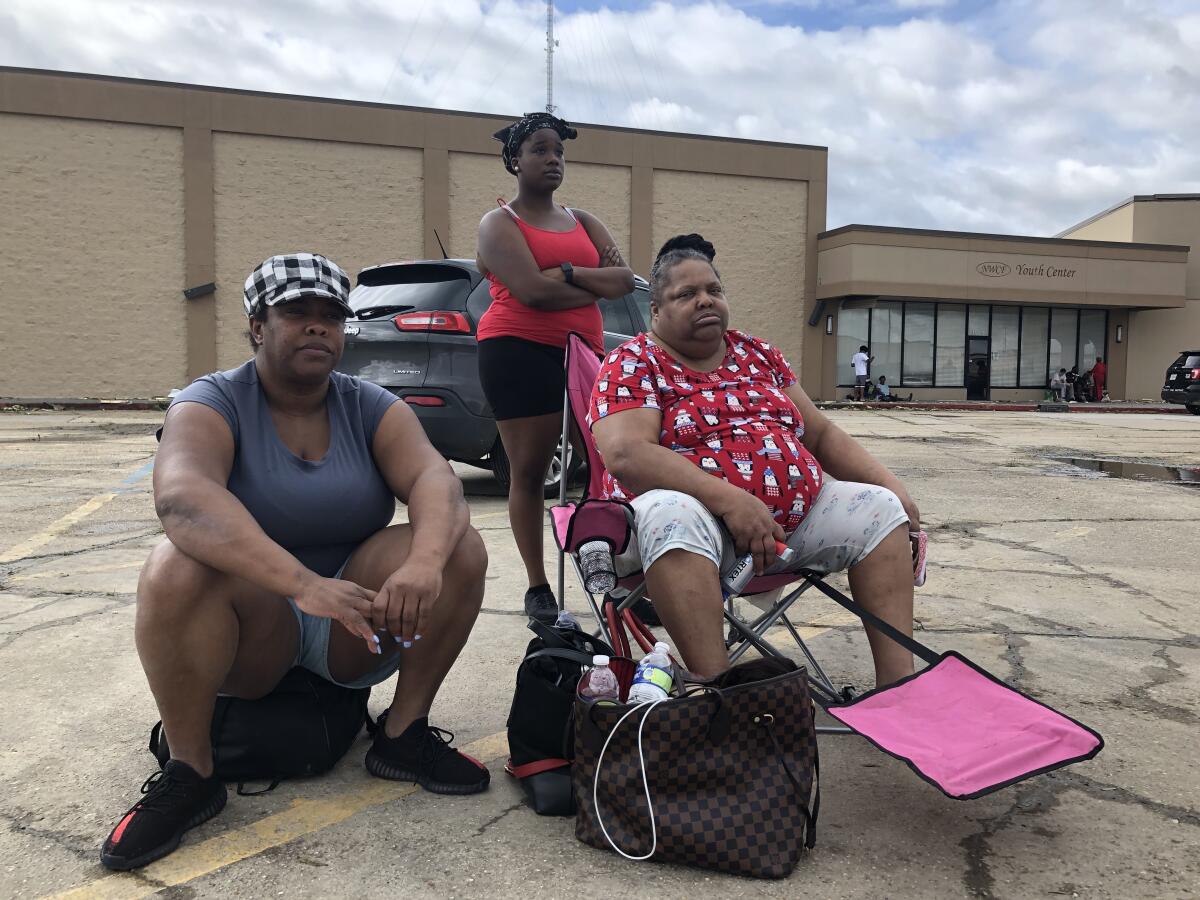
Demetrice Joseph also felt safer outside, especially since she wasn’t able to grab a mask when she left her waterlogged home. Nor did she see any masks at the shelter when she lined up to check in.
“We don’t want to catch it,” she said as she and several relatives kept their distance from a growing crowd of evacuees, most not wearing masks. Joseph was particularly concerned about her mother, who has asthma and chronic obstructive pulmonary disease. “My mom shouldn’t be around that many people.”
Louisiana Gov. John Bel Edwards spoke forcefully about the COVID-19 threat. In recent weeks, the state — which has one of the nation’s lowest COVID-19 vaccination rates — was logging more than 5,000 new coronavirus cases per day.
“Whether we like it or not, we are still in a COVID environment; it is a very difficult COVID environment, where 100% of our cases are attributable to this Delta variant,” he said. “Everything we’re doing needs to be done with COVID in mind, so it’s important we mask and wash hands and do all of these things to the maximum extent possible.”
That message apparently didn’t impress Cain Dufrene, the chief of operations for St. John the Baptist Parish Fire Services.
“I’ll be honest with you. ... We really didn’t take too many COVID protocols,” he said after pulling a 30-hour shift. “We’re going to save the life rather than trying to worry too much about the COVID stuff.”
Like many of the local officials and emergency workers huddled inside the St. John command center, Dufrene did not wear a mask.
California’s vaccination progress
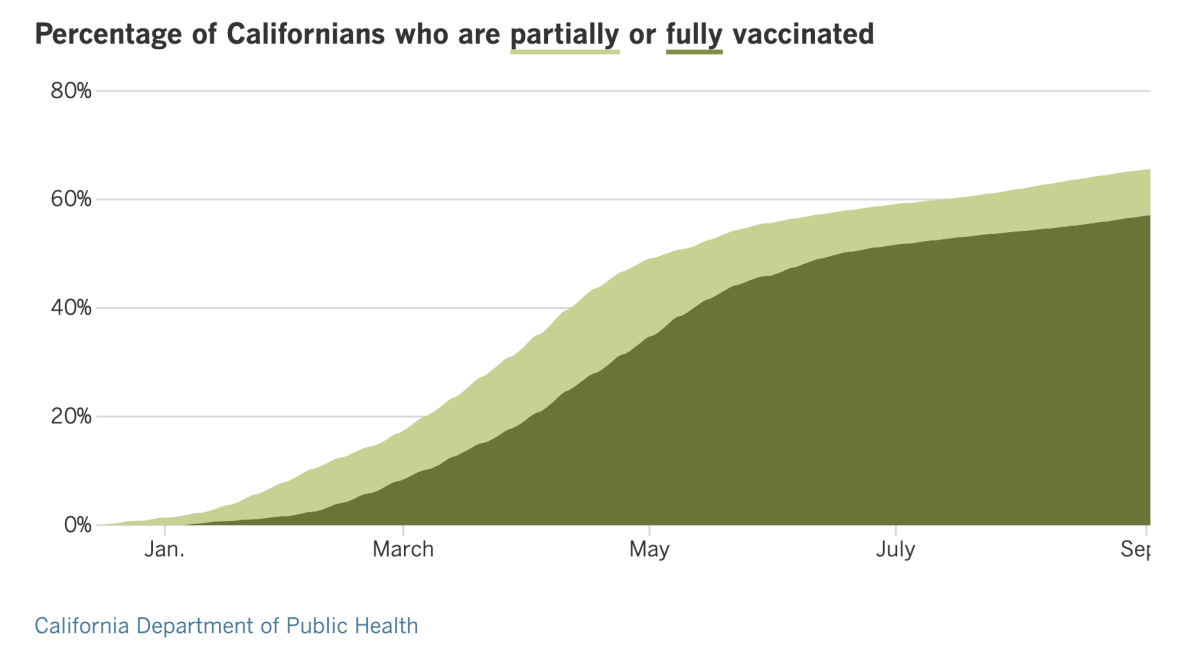
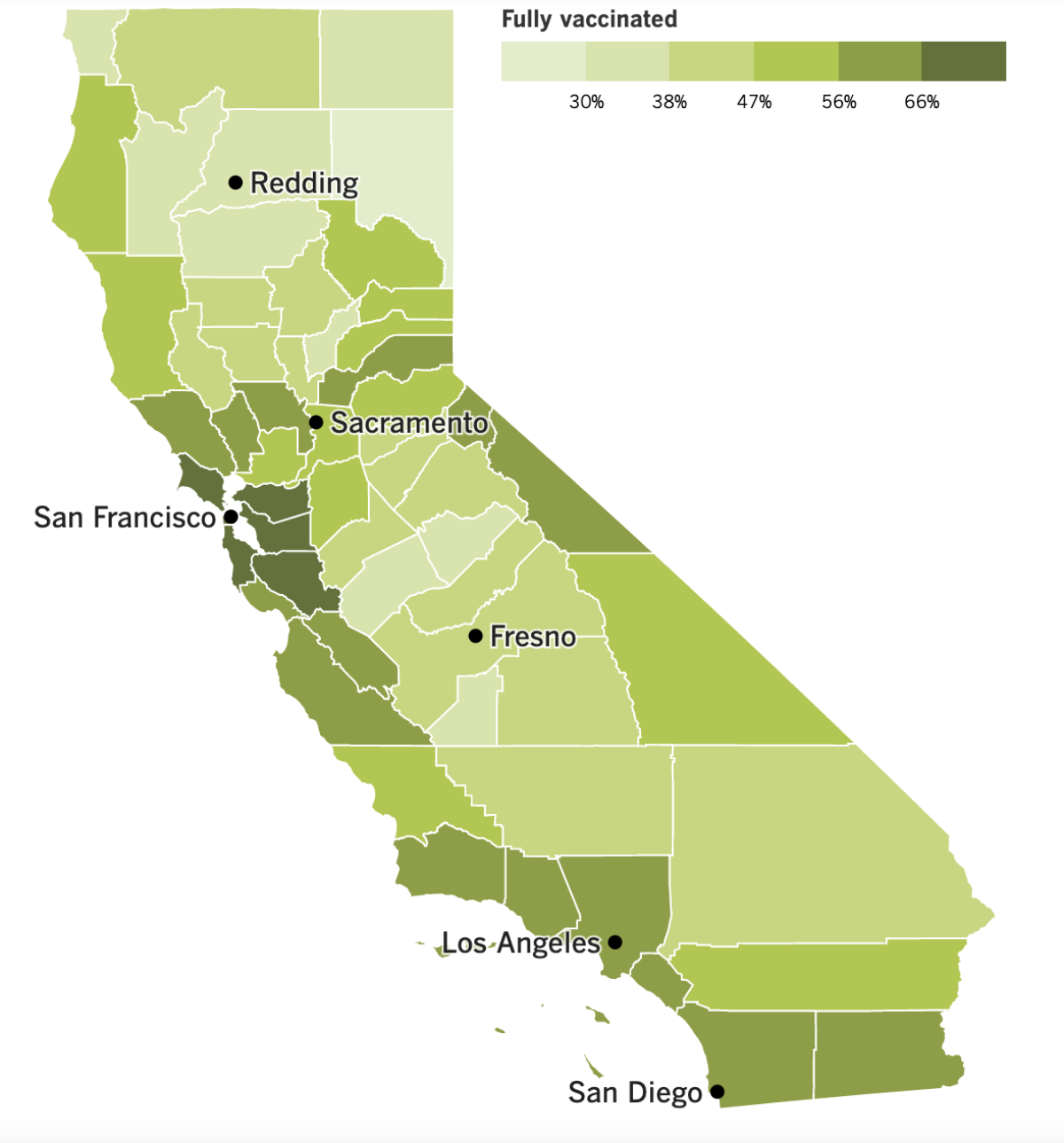
See the latest on California’s vaccination progress with our tracker.
Consider subscribing to the Los Angeles Times
Your support helps us deliver the news that matters most. Become a subscriber.
In other news …
Meetings of the Los Angeles County Board of Supervisors routinely include reports from the county’s top public health officials, and the five supervisors often spend an hour or more listening to the experts and asking them questions.
But in neighboring Orange County, it’s been two months since the leader of the O.C. Health Care Agency formally briefed the Board of Supervisors on the pandemic at one of its public meetings.
In L.A. County, the Department of Public Health recently increased the frequency of live COVID-19 press briefings to twice a week. In the O.C., such briefings were suspended for several months.
Supervisor Katrina Foley, a former mayor of Costa Mesa, was concerned that O.C. residents were not getting the facts they needed to combat the rampant misinformation they might be hearing about COVID-19, vaccines and the Delta variant. So on Aug. 9, she launched her own regular COVID-19 news conference.
The briefings were initially held five days a week, though they’ve dropped in frequency to twice a week. They feature county health officials and other experts, who warned the public that local hospitals were beginning to strain under the Delta surge. They also gave updates on conditions in schools, explained why it’s important to wear masks and offered tips on maximizing safety over the Labor Day weekend.
But on Thursday, the chair and vice chair of the Board of Supervisors ordered county officials to stop participating in Foley’s briefings.
Board Chairman Andrew Do called them political stunts that repeated information already available elsewhere. The Orange County Health Care Agency resumed its own weekly press briefings Aug. 13 — after Foley’s news conferences had begun.
Foley said she’d continue hosting the briefings without county health officials if necessary. She could try to replace them with experts from the state Department of Public Health. She already features doctors from local hospitals, epidemiologists and other healthcare professionals.
“We’re just trying to give accurate health information out to the community,” she said. “I think the information that we’ve been sharing has caused more people to question some of the misinformation that’s coming out.”
Farther south, officials in San Diego County voted this week to declare medical misinformation a public health crisis — the first county in the country to do so.
The Board of Supervisors took the vote after a 15-hour meeting that included eight hours of public comments, much of it critical of vaccine and mask mandates. The three Democratic supervisors voted in favor of the measure, while the two Republican supervisors voted against it.
Supervisor Nathan Fletcher said the measure was necessary to ensure that false and misleading statements don’t get in the way of doctors’ and nurses’ efforts to treat a rising tide of COVID-19 patients. The Republicans, Jim Desmond and Joel Anderson, said that although they support vaccination efforts, they consider it government overreach to try to referee debate about the pandemic.
Speaking of vaccines, the L.A. Community College District Board of Trustees has voted to require them for all staff members — even those working remotely — and for students attending in-person classes or using campus facilities.
The vote to revise the policy — which previously called for either a COVID-19 vaccination or regular coronavirus testing — is linked to the federal government’s official approval of the Pfizer-BioNTech vaccine for people 16 and older. It passed 7-1, with trustee Ernest Moreno voting no.
Medical and religious exemptions will be allowed. Those exempted will be required to get tested at least once a week.
In national news, the Delta variant has thrown us an economic curveball that prompted employers to add just 235,000 new jobs to their payrolls last month. That’s one-third as many as most forecasters were expecting based on hiring trends earlier in the summer. Retail stores and restaurants and drinking places shed jobs last month.
With Delta walloping unvaccinated Americans and causing problems for groups that had seemed relatively unaffected by earlier strains, the wave of consumer spending that had propelled the recovery has faltered. Many businesses are reconsidering plans to return to their normal operations.
Without some kind of government action, “I think the rosy scenario for this fall becomes really dark, really fast,” said William Spriggs, chief economist for the AFL-CIO, the labor organization.
The employment news comes as the federal government ends four temporary programs that were designed to help those who were unemployed or underemployed weather the pandemic. Those programs were providing more than $1 billion in aid to about 2.2 million Californians as of late August, according to the state Employment Development Department.
Gone will be $300 in weekly unemployment benefits that the feds were offering on top of the state’s unemployment insurance. Also disappearing is $839 million in help for gig workers, self-employed people and others who aren’t eligible for unemployment benefits.
As things stand, the situation will soon get worse: On Sept. 11, the 13- to 20-week extension of federal unemployment benefits will end. At that point, the maximum duration of benefits will be 26 weeks, and those who have already hit that mark will be cut off.
Your questions answered
Today’s question comes from readers who want to know: What is the coronavirus situation in my child’s school?
If your child is a student in L.A. Unified, you’re in luck: We’ve got you covered with our new LAUSD coronavirus tracker!
As previously discussed, the school district has implemented a $350-million testing program that’s the most ambitious effort of its kind in the country. With half a million test results coming out each week, there’s plenty of data to slice and dice.
Our handy dashboard makes it easy to see how many active cases there are among students, teachers and staff, and to track changes in that number over time.
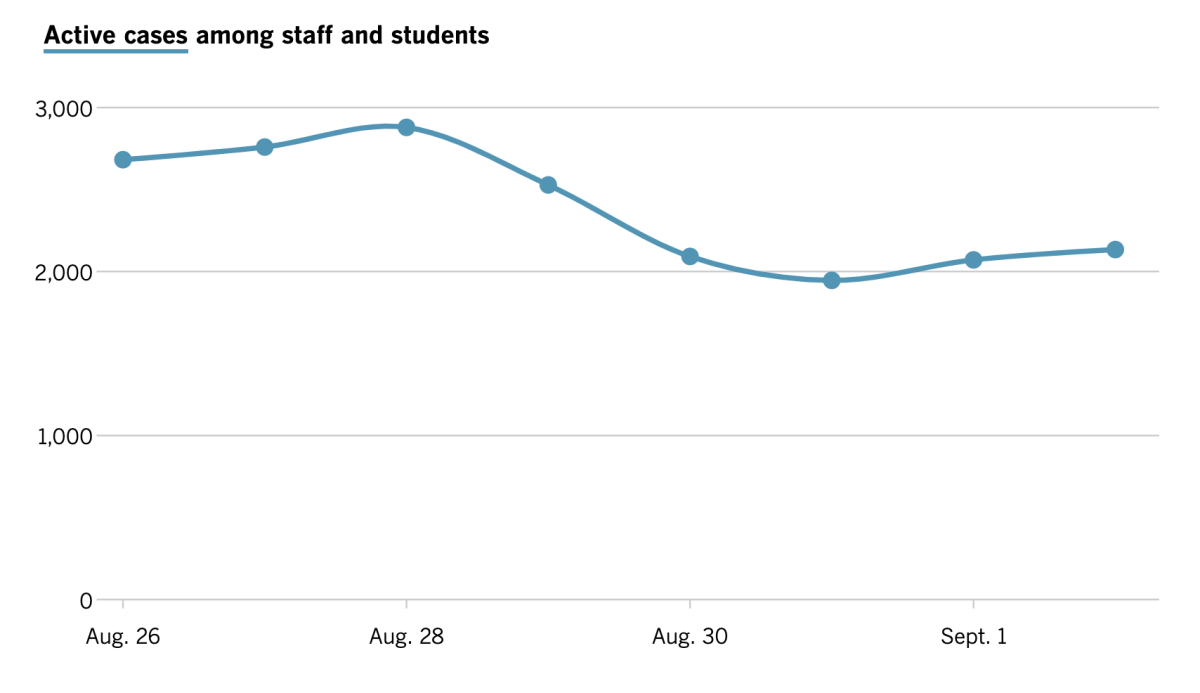
You can also see how many schools are dealing with an active outbreak, which LAUSD defines as three or more cases transmitted at school over a two-week period. As of Friday, there were two.
If you keep scrolling, you’ll see a place to type in the name of your child’s school to see their case counts. There’s also the option of seeing all schools in a community, from Baldwin Hills to Woodland Hills.
We want to hear from you. Email us your coronavirus questions, and we’ll do our best to answer them. Wondering if your question’s already been answered? Check out our archive here.
The pandemic in pictures
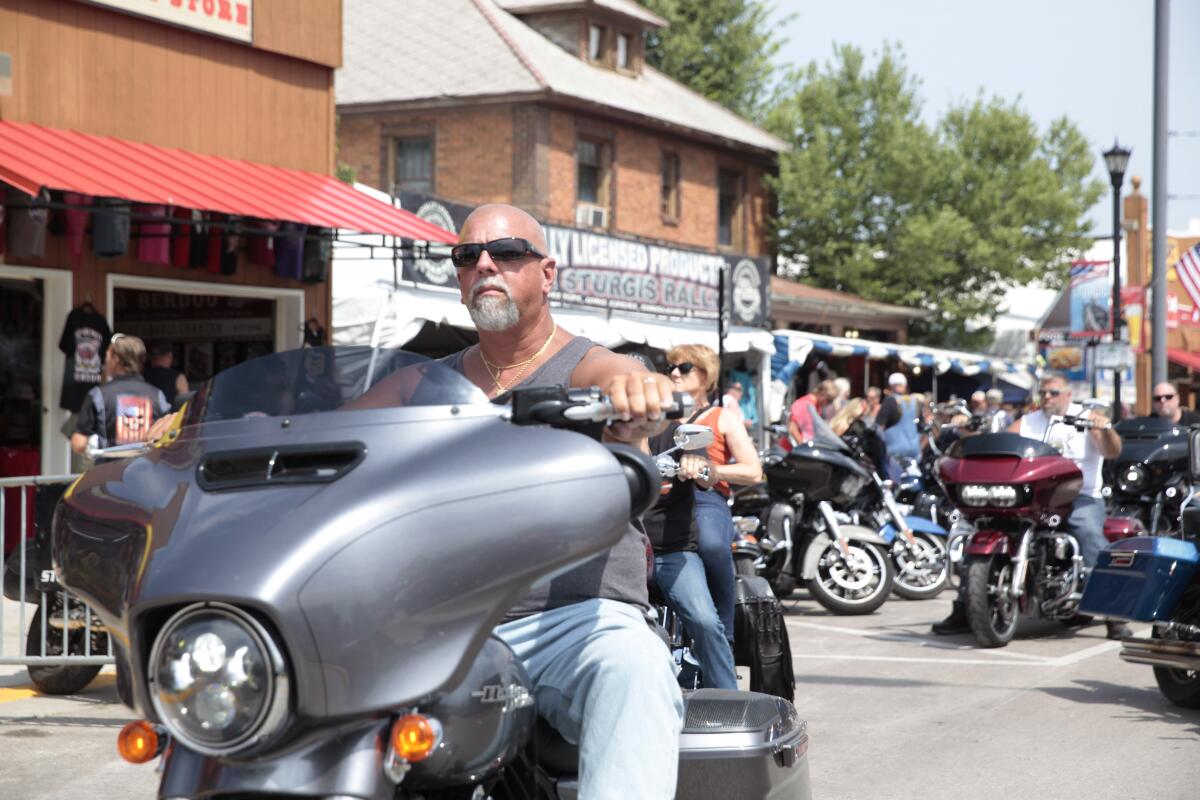
Three weeks ago, motorcycles like the one pictured above were rumbling through the Black Hills of South Dakota for the Sturgis Motorcycle Rally. The 10-day gathering occurred despite warnings about the highly contagious Delta variant and drew more than half a million people.
Experts feared the rally would become a superspreader event. It looks like they were right.
Contact tracers have tied at least 178 coronavirus cases to the event. Those cases are from five states: South Dakota, North Dakota, Wyoming, Minnesota and Wisconsin. Meade County, the nucleus of the rally, is now dealing with a COVID-19 surge, and the region’s largest hospital system went from treating five COVID-19 patients to 78 — and it’s bracing for more.
Two bands that performed at the rally were forced to cancel shows after musicians became infected. Corey Taylor, the lead singer of Slipknot, told fans he was “very, very sick” from COVID-19.
“This is the worst I’ve ever been sick in my life,” Taylor said in a Facebook video this week. “Had I not been vaccinated, I shudder to think how bad it would have been.”
Resources
Need a vaccine? Sign up for email updates, and make an appointment where you live: City of Los Angeles | Los Angeles County | Kern County | Orange County | Riverside County | San Bernardino County | San Diego County | San Luis Obispo County | Santa Barbara County | Ventura County
Need more vaccine help? Talk to your healthcare provider. Call the state’s COVID-19 hotline at (833) 422-4255. And consult our county-by-county guides to getting vaccinated.
Practice social distancing using these tips, and wear a mask or two.
Watch for symptoms such as fever, cough, shortness of breath, chills, shaking with chills, muscle pain, headache, sore throat and loss of taste or smell. Here’s what to look for and when.
Need to get tested? Here’s where you can in L.A. County and around California.
Americans are hurting in many ways. We have advice for helping kids cope, resources for people experiencing domestic abuse and a newsletter to help you make ends meet.
We’ve answered hundreds of readers’ questions. Explore them in our archive here.
For our most up-to-date coverage, visit our homepage and our Health section, get our breaking news alerts, and follow us on Twitter and Instagram.




